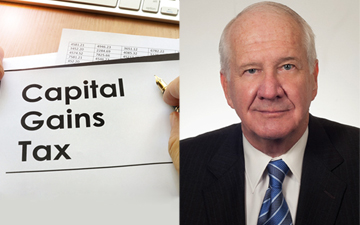Crystallizing capital gains before June 25: What about the GAAR?

Allan Lanthier explains why the General Anti-Avoidance Rule, as amended by Bill C-59, should not apply to a planning alternative to new capital gains rules
 |
Read Allan Lanthier's earlier article, "New Game in Town," for a planning alternative to new capital gains rules. (CLICK ON IMAGE) |
MONTREAL – The government’s budget of April 16, 2024 included a proposed increase in the capital gains inclusion rate from 50 per cent to two-thirds, effective for capital gains realized on or after June 25, 2024. The fact that the increase did not take effect on the budget date means that many taxpayers will be forced to crystallize capital gains before June 25.[1]
Last week, I set out one planning alternative that may reduce the immediate tax hit somewhat:[2] the rollover of capital properties by an individual to a corporation as a first step,[3] followed by a corporate realization of the capital gains. While I commented briefly on the general anti-avoidance rule, this article provides a more complete analysis as to why the GAAR, as amended by Bill C-59,[4] should not apply.
Effective tax rates
Depending on the facts and circumstances, if an individual transfers a capital property to a Canadian-controlled private corporation under subsection 85(1) and the CCPC then crystallizes the capital gain before June 25, the effective tax rate — both short and long-term — can be reduced when compared to the rate that would have applied had the individual crystallized the gain personally.
In last week’s example, Crystal, a top-bracket individual resident in Vancouver, owned 100 per cent of Co. A with an accrued gain of $10 million. Had she realized the gain directly, her federal rate before June 25 could be as high as 20.5 per cent, including alternative minimum tax (AMT) of four percentage points, and her provincial rate as high as 11.60 per cent, including 1.35 per cent of provincial AMT. The highest possible combined federal-provincial personal tax is therefore 32.10 per cent in British Columbia for a capital gain with a 50 per cent inclusion rate.
If Crystal transfers the shares to a CCPC and the CCPC crystallizes the gain, the CCPC’s federal and provincial tax will be 19.34 and 6.00 per cent respectively: 25.34 per cent in total.[5] The short-term savings on a gain of $10 million is $676,000.
In the long-term, after the CCPC pays non-eligible dividends to Crystal and recovers its refundable dividend tax on hand, the combined personal-corporate rate is 15.03 per cent federally and 14.53 per cent in British Columbia, or 29.56 per cent in total:[6] still a savings of $254,000 when compared with an up-front personal rate as high as 32.10 per cent.
The issue
The issue is whether the rate differentials noted above are significant enough to suggest that the transfer of the Co. A shares to the CCPC is a misuse or abuse, such that the GAAR should apply to deny the rollover. In my view, they are not.
First, the purpose of subsection 85(1) is precisely to defer and preserve the recognition of a capital gain in internal reorganizations: also, the courts have held that the amount of tax the transferee suffers following the rollover is generally not relevant in a GAAR analysis.
Second, a basic principle of the Act since 1971 tax reform is integration, meaning taxpayers should be indifferent whether investment income, including the taxable portion of capital gains, is earned or realized personally or by a private corporation. I comment on both issues below.
There is no abuse of subsection 85(1):
Capital gains became subject to tax as part of 1971 tax reform, and Parliament added a number of rollover provisions to the Act at that time so that taxation was deferred when assets are transferred as part of internal reorganizations. One of those provisions was subsection 85(1), which permitted a taxpayer to transfer eligible assets to a Canadian corporation on a rollover basis provided, immediately after the transfer, that the taxpayer owned not less than 80 per cent of each class of shares of the corporation.
While a number of technical amendments have been made to subsection 85(1) over the years, there has been no change in its purpose — to permit deferral of taxation in internal reorganizations provided the conditions set out in the provision are satisfied. For example, property eligible for rollover excludes real property inventory and capital property that is real property owned by a non-resident. A taxpayer who seeks to avoid these limitations invites scrutiny under the GAAR: that is not the situation here.
Also, the courts have held that the amount of tax paid by the transferee following a rollover under subsection 85(1) is generally not relevant.
In Veracity Capital,[7] the British Columbia Court of Appeal rejected the proposition that a broad reading of the federal GAAR should apply following a rollover under subsection 85(1), or that any transaction that leads to lower taxes represents an abuse, adding that “This would be akin to suggesting the overarching policy of the Act is to collect taxes, but since a transaction results in lower taxes payable or for a smaller base (or a reduction in taxable capital gains), the Act’s purpose, spirit and object were abused.”[8]
Veracity Capital involved a so-called “Quebec year-end shuffle” that avoided provincial tax on 90 per cent of a taxable capital gain. The court found, in part, that the Minister had not clearly demonstrated that the taxpayer had abused subsection 85(1).[9] The court also found that the federal rollover provision was meant to defer and preserve taxation until a third-party disposition of the transferred asset, but not to ensure that an ultimate gain would actually give rise to a tax liability.
The Quebec Court of Appeal reached a somewhat different conclusion in OGT Holdings,[10] a decision involving another variation of the “Quebec shuffle”, in a transaction that sought to completely eliminate any provincial taxation (a capital asset had been transferred to a corporation taxable in Ontario).
In OGT Holdings, the court stated that article 518 of the Quebec Taxation Act (the provincial equivalent of subsection 85(1) of the Act) allows a rollover, but on the condition that the transferee is taxable, therefore assuming that a tax will ultimately be paid on the capital gain. It found that, under the Quebec GAAR, the rollover provision had been abused because it eliminated rather than deferred provincial tax. However, it seems clear that there would have been a contrary finding had the gain been taxed, at whatever rate, by the province of Ontario.[11]
Unlike Veracity Capital and OGT Holdings, the issue here is not the use of subsection 85(1) (or a provincial counterpart) to eliminate a very significant part of personal and corporate tax that would otherwise apply. To the contrary, the exercise involves some fairly routine effective tax rate calculations, not unlike those involved on an annual basis in considering the payment of salaries or bonuses versus dividends by a CCPC to its owner-manager. It is nothing more than ordinary-course planning.
A transfer of capital properties to a CCPC is consistent with the object, spirit and purpose of tax integration:
Tax integration has been a fundamental principle of the Canadian tax regime since 1971 tax reform. As noted above, integration means that taxpayers should be indifferent whether investment income, including the taxable portion of capital gains, is earned or realized personally or by a private corporation: indifferent in the sense that the income will be taxed at approximately the same rate in either case. As the government noted at the time,[12] integration was introduced to achieve greater fairness and efficiency under the Act.
Tax integration does not mean perfection of course: it means that the tax cost of earning investment and business income in a corporation should be approximately the same as would have been the case had the income been earned by an individual: however, changes to individual and corporate tax rates, and the factors used for dividend gross-ups and credits, mean that there will always be tax rate differentials.
The new GAAR
The new GAAR includes a preamble, a revised threshold for an “avoidance transaction” and an economic substance rule. However, this does not mean that we are starting from scratch.
We have years of guidance from the courts with respect to the concepts of misuse and abuse, and that guidance remains in place. One of the new provisions states that, if an avoidance transaction is significantly lacking in economic substance, “this is an important consideration that tends to indicate” misuse or abuse.[13] But the analysis does not end there.
Quite apart from the fact that a transfer of assets to a corporation does have economic substance (creditor proofing as only one example), the real test is whether the object, spirit and purpose of subsection 85(1), or the Act read as a whole, have been misused or abused. For the reasons noted in this article, I conclude that they have not.
Published government positions
Finally, published positions of both the CRA and Finance Canada clearly support the position that this type of planning is not abusive.
First, in Information Circular 88-2,[14] the CRA states that a subsection 85(1) transfer of a capital asset to a corporation to which subsection 69(11) does not apply is acceptable “as it is within the object and purpose of the Act”.
Second, in November 2023, Finance Canada issued Explanatory Notes related to certain legislative proposals, including the proposed changes to the GAAR.
In discussing the new preamble to the GAAR, the Notes state that it may be reasonable to conclude that Parliament contemplated rules intended to ensure corporate integration of income (such as RDTOH and the capital dividend account) being used in a way that achieves integration, but would not have contemplated the same rules being used to break integration.
Also, when discussing the economic substance rule, the Notes comment (favourably) on the incorporation of a business under subsection 85(1) immediately before an individual sells the shares of Newco to a third-party, so that the individual can access the lifetime capital gains exemption and avoid tax on her entire gain. The transaction discussed in this article does not seek exemption from tax: it is simply based on tax rate differentials that vary from individual to individual.
Finally, in a technical interpretation dated April 29, 2024 (doc. no. 2024-1016011E5(E)), the CRA stated, in part, as follows:
“…it is our view that where a taxpayer crystallizes an accrued capital gain prior to the increase in the capital gains inclusion rate, the GAAR would generally not apply to redetermine the inclusion rate in respect of the crystallized capital gain.”
The caveat added by the CRA in its following paragraph is that the crystallization of an accrued gain that is part of a series of transactions one of the purposes of which is to obtain a tax benefit other than, or in addition to, taxation at the 50 per cent inclusion rate would not be immune from scrutiny under the GAAR: however, the only example given in that paragraph is a “surplus strip” – the extraction of corporate surplus other than in the form of a dividend.
Conclusion
The federal government has forced taxpayers into a difficult position: taxpayers must decide in less than six weeks whether or not to prepay tax on accrued capital gains and, if so, how best to crystallize the gain. For many, this will require putting pen to paper and completing laborious calculations and estimates.
The transaction described in this article may reduce the tax hit somewhat in appropriate circumstances. But simply put, it is not a sophisticated strategy “designed to yield tax advantages that were not intended by Parliament”.[15]
Footnotes
[1] See for example Brian J. Arnold, “Increasing the Capital Gains Inclusion Rate; Forcing the Realization of Capital Gains”; The Arnold Report, Posting 281, May 9, 2024: Canadian Tax Foundation.
[2] “The new game in town: Capital gains and the alternative minimum tax”; Allan Lanthier, May 10, 2024: Canadian Accountant.
[3] In accordance with subsection 85(1) of the federal Income Tax Act; RSC 1985, c. 1 (5th Supp.), as amended (referred to in this article as the “Act”).
[4] The Fall Economic Statement Implementation Act, 2023.
[5] Federal-provincial rate of 50.67 per cent in British Columbia (including refundable tax), at a 50 per cent inclusion rate.
[6] The reason the long-term effective federal rate is lower than the short-term rate of 19.34 per cent is that the federal government bears the entire cost of the refund of RDTOH.
[7] Veracity Capital Corporation v. The Queen: 2017 DTC 5005.
[8] Ibid., at paragraph 92.
[9] Ibid., at paragraph 93.
[10] OGT Holdings Ltd. c. Québec: 2009 QCCA 191.
[11] Ibid., at paragraphs 23 and 24.
[12] “Summary of 1971 Tax Reform Legislation”; Honourable E.J. Benson, Minister of Finance.
[13] Proposed subsection 245(4.1) of the Act.
[14] Dated October 21, 1988.
[15] “Supplementary Information Relating to Tax Reform Measures” tabled in the House of Commons on December 16, 1987.
Allan Lanthier, a retired partner of an international accounting firm, has been an adviser to both the Department of Finance and the Canada Revenue Agency.









(0) Comments